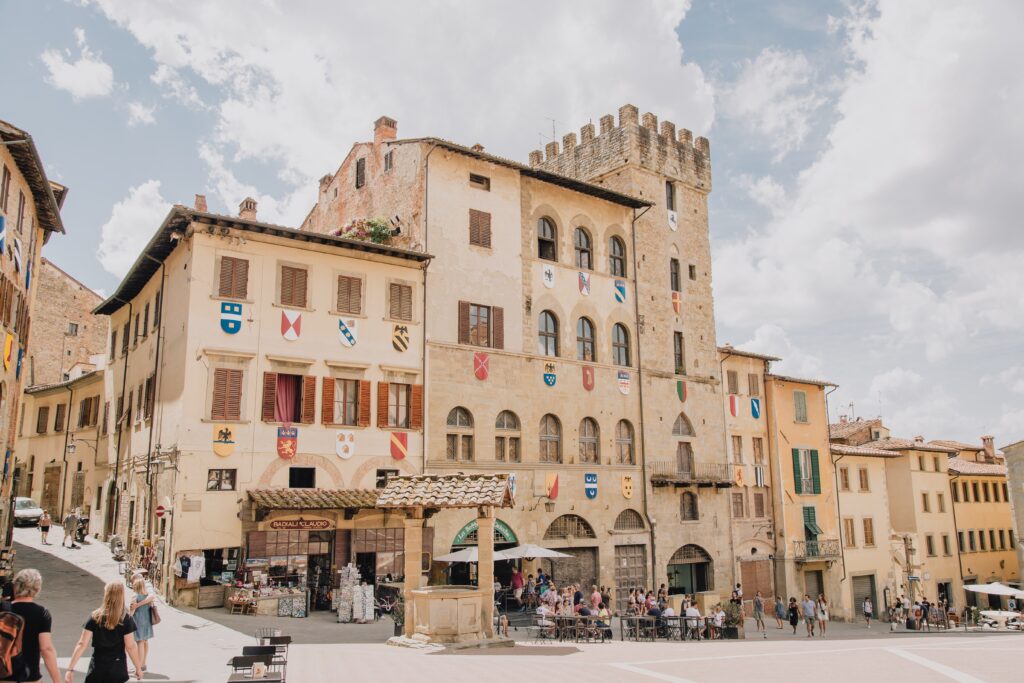
Information:
History
For a chronological guide, see Timeline of Arezzo.
Described by Livy as one of the Capita Etruriae (Etruscan capitals), Arezzo (Aritim in Etruscan) is believed[by whom?] to have been one of the twelve most important Etruscan cities—the so-called Dodecapolis, part of the Etruscan League. Etruscan remains establish that the acropolis of San Cornelio, a small hill next to that of San Donatus, was occupied and fortified in the Etruscan period. There is other significant Etruscan evidence: parts of walls, an Etruscan necropolis on Poggio del Sole (still named “Hill of the Sun”), and most famously, the two bronzes, the “Chimera of Arezzo” (5th century BC) and the “Minerva” (4th century BC) which were discovered in the 16th century and taken to Florence. Increasing trade connections with Greece also brought some elite goods to the Etruscan nobles of Arezzo: the krater painted by Euphronios c. 510 BC depicting a battle against Amazons (in the Museo Civico, Arezzo 1465) is unsurpassed.
Conquered by the Romans in 311 BC, Arretium became a military station on the via Cassia, the road by which Rome expanded into the basin of the Po. Arretium sided with Marius (157 – 86 BC) in the Roman Civil War, and the victorious Sulla (c. 138 – 78 BC) planted a colony of his veterans in the half-demolished city, as Arretium Fidens (“Faithful Arretium”). The old Etruscan aristocracy was not extinguished: Gaius Cilnius Maecenas, whose name has become eponymous with “patron of the arts”, came of the noble Aretine Etruscan stock. The city continued to flourish as Arretium Vetus (“Old Arretium”), the third-largest city in Italy in the Augustan period, well known in particular for its widely exported pottery manufactures, the characteristic moulded and glazed Arretine ware, bucchero-ware of dark clay and red-painted vases (the so-called “coral” vases).
Around 261 AD the town council of Arezzo dedicated an inscription to its patron L. Petronius Taurus Volusianus. See that article for discussion of the possible political/military significance of Volusianus’s association with the city.
In the 3rd to 4th century Arezzo became an episcopal seat: it is one of the few cities whose succession of bishops are known by name without interruption to the present day, in part because the bishops operated as the feudal lords of the city in the Middle Ages. The Roman city was demolished, partly in the course of the Gothic War and of the late-6th-century invasion of the Lombards, partly dismantled, as elsewhere throughout[citation needed] Europe. The Aretines re-used the stones for fortifications. Only the amphitheater remained.
The commune of Arezzo threw off the control of its bishop in 1098 and functioned as an independent city-state until 1384. Generally Ghibelline in tendency, it opposed Guelph Florence. In 1252 the city founded its university, the Studium. After the rout of the Battle of Campaldino (1289), which saw the death of Bishop Guglielmino Ubertini [it], the fortunes of Ghibelline Arezzo started to ebb, apart from a brief period under the Tarlati family, chief among them Guido Tarlati, who became bishop in 1312 and maintained good relations with the Ghibelline party. The Tarlati sought support in an alliance with Forlì and its overlords, the Ordelaffi, but failed: Arezzo yielded to Florentine domination in 1384; its individual history became subsumed in that of Florence and of the Medicean Grand Duchy of Tuscany. During this period Piero della Francesca (c. 1415–1492) worked in the church of San Francesco di Arezzo producing the splendid frescoes, recently restored, which are Arezzo’s most famous works. Afterwards the city began an economical and cultural decay, which ensured the preservation of its medieval centre.
In the 18th century the neighbouring marshes of the Val di Chiana, south of Arezzo, were drained[by whom?] and the region became less malarial. At the end of the-century French troops led by Napoleon Bonaparte conquered Arezzo, but the city soon turned (1799–1800) into a resistance base against the invaders with the “Viva Maria” movement, winning the city the role of provincial capital. In 1860 Arezzo became part of the Kingdom of Italy.
City buildings suffered heavy damage during World War II; the Germans made a stand in front of Arezzo early in July 1944 and fierce fighting ensued before the British 6th Armoured Division, assisted by New Zealand troops of the 2nd New Zealand Division, liberated the town 16 July 1944. The Commonwealth War Graves Commission‘s Arezzo War Cemetery, where 1,266 men are buried, is located to the north-west of the city.[10]
Pope Benedict XVI visited Arezzo and two other Italian municipalities on May 13, 2012.
all the information come from Wikipedia, the free encyclopedia.
